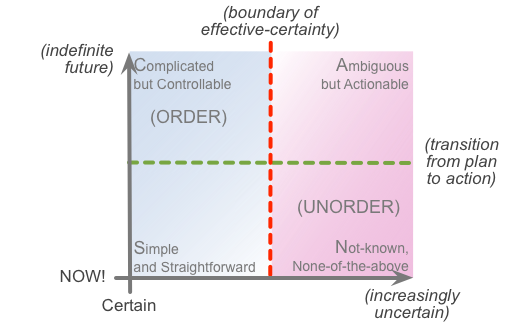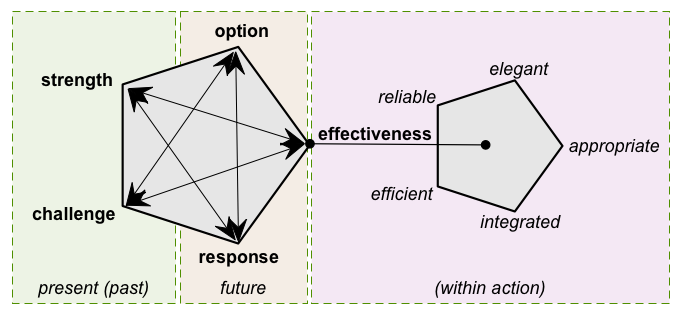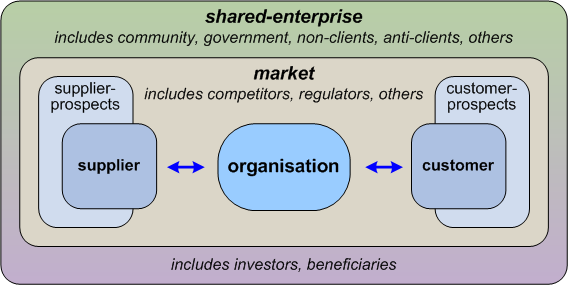Calling a halt
Enterprise-architecture is a mess.
And I’m not the one to fix it.
That’s become all too clear to me right now – particularly after the farrago around that previous couple of posts about specialism-trolling, and the almost total non-response to that pair of in-depth series that preceded them.
At the very least, we do need to stop pretending that enterprise-architecture right now is anything much more than a near-irredeemable mess. I’ve done my best to sort it out over the past few years, but there are just too many vested-interests in it remaining the same near-irredeemable mess. Let’s be blunt about this: the trailing-edge of enterprise-architecture is a straight-out disaster-area, riddled with people still trying to drag EA back into the 1980s at best; and even most of the purported leading-edge of EA is still somewhat stuck in the past, mired in self-important ‘solutioneering’ around the supposed centrality of IT in everything. By contrast, I’ve been focussed forward onto the needs for the next few decades, on tools that would support a literal ‘architecture of the enterprise’ for every type of context, at every level, all the way up to a full global scope. There’s kind of a mismatch in expectations there…
There are still way too many stupid arguments around EA, that should have been resolved long since. Such as about what is or isn’t in scope (real answer: whatever the scope of the enterprise is). Or whether something is or isn’t fractal (real answer: it’s fractal when something is self-similar – both same and different – at multiple scales). Or whether… well, choose-your-argument, really, there’s any number of ’em. 😐 Utterly pointless, all of it.
And I literally do not have the time to waste on that kind of crap any more. I can’t wait around for the rest of the EA world to catch up – and for even the supposed ‘leading-edge’ of EA to wake up to some really fundamental truths about the trade that should have been more than self-evident at least a decade or more ago. Oh well.
Sigh.
So I’m calling a halt on this.
No more arguments. If you don’t like what I say, or the way I do things, go somewhere else.
I know I’ve alienated some real colleagues recently about this, but I just don’t have that kind of time or energy to waste. Not any more. Not at my rather-too-advanced age, certainly.
— If you want to know how to work with the future of enterprise-architecture, or how to work with real enterprise-architectures that extend a long way beyond the arbitrary confines of big-IT, take a wander around here for a while.
— If you want to stay stuck in EA’s past, take a look around just about anywhere else.
Sure, that might sound a bit arrogant at first, but that’s just too bad. Whether you take me seriously or not is up to you. That’s your choice: I’m not going to argue about it, anyway. Simple as that, really.
In some ways I perhaps shouldn’t even describe myself as an enterprise-architect these days – though to be brutally blunt, I know a lot more about both the theory and the practice of enterprise-architecture than many of those who parade themselves around with that label. Instead, I make tools for enterprise-architecture – tools for change. Or, to be more precise, I make meta-tools that help and guide others to build their own tools for change within their own specific context.
That’s what I do: I make meta-tools for a literal ‘architecture of the enterprise’ and the like. Tools such as SCAN, for example, for mapping out sensemaking and decision-making:
Or SCORE, for strategy-work:
Or Enterprise Canvas, for service-oriented enterprise-architecture:
…and its subsidiary tools such as the ‘holomap’, mapping out the enterprise context and stakeholders:
Right now I’m perhaps the only person who does any of this kind of work in the enterprise-architecture space – on a consistent basis, at least, with meta-tools that are designed to work consistently across the whole of that space. Yes, these tools are usable for any kind of architecture, so yes, they can be used for IT-architectures too. But to constrain them to IT-architecture alone is to miss the point – in exactly the same sense that to constrain ‘enterprise’-architecture to IT-architecture is to miss the point. Yet as per the previous post, people get so hung up on that point that they miss the real point: in any real architecture, the point is that there is no ‘the point’ – everything depends on everything else, there’s only ever ‘the everything’, in which everywhere and nowhere is ‘the point’, all at the same time.
In a way, those tools that I make are nothing special. They’re not all glitzed-up and glossy, like This Year’s Model straight off the car-lot: they’re plain old everyday workhorses, the tractors and Transit-vans and Toyota Landcruisers of the EA world, built for reliability, versatility, adaptability in the face of anything that we might need to throw at them. They work. Quietly, in the background, without fuss or bother or razamatazz or certification-scams: they just work. Yet those tools do depend on specific understandings, specific terminology: and I’m very clear about that – such as that crucial distinction between ‘is true’ versus ‘as-if true’, for example, that still scarily-few people seem to understand…
If you want to talk about the tools themselves – how to use the tools, in real-world practice – then yeah, I’d really like to know about that. Very happy to talk with you, to explore, to argue, to find the best way to adapt the tools, find the best to get something to work for some specific purpose, some specific context, then yes, sure.
But if you just want to tell me I’m wrong, because what I’m doing doesn’t make sense in terms of someone else’s narrow-focus theory, which itself probably doesn’t even make sense in its own terms anyway, let alone anywhere else? Nah, not interested, not going to play that game: don’t bother, just include me out, okay?
It should, I hope, be self-evident that trying to play random mix-and-match with terminology and suchlike, without understanding any of the distinctions between tools and meta-tools, or how they work or what they’re built for? – well, yeah, that’s never going to work well, is it? Likewise trying to use them completely out of context? – well, yeah, no surprise that doesn’t work well either. Kinda stupid right from the start, like complaining that a heavy-duty agricultural tractor doesn’t have a high 0-60mph acceleration or the right attachment-points for the baby-carriage or the bicycle trainer-wheels, or that the high cabin and the power-take-off shaft and the lack of go-faster stripes make it look it kind of ugly at the shopping-mall. You what…?!?
And yet that’s exactly that I’m seeing so often right now in enterprise-architecture, just about everywhere, just about all of the time. Despite all of my warnings about this, people do keep on doing or demanding exactly those kinds of kludges, or demand to use it with someone else’s seriously-substandard tools, and then wonder why it doesn’t work. And then make it out that it’s somehow all my fault that they can’t make sense of the resultant mess. And then expect me to sort it out for them all over again, at my own expense in every sense, whilst they sit on the sidelines, grumbling, complaining and, in too many cases, mocking me as well.
So yeah, I’ve kinda had enough of that, thank you… – and I’m calling a halt on that kind of crap.
Nope, sorry, folks, I’s just not gonna play those kinda games no more. I’m not going to argue about it. If you can’t be bothered to listen, and you break it, or can’t be bothered to use it properly, you can darn well fix it yourself – don’t complain at me. I’ve got better things to do with what little remains of my life.
Enough said for now.




Tom – I’d just like to say thank you to you for ploughing your lonely furrow. I think what you’ve done and produced is a fine body of work, something that I fall back on as THE reference point when I need to reflect on fundamentals.
Unfortunately it seems that the way of the World is not to value rigorous thinking nor rigorous thinkers, whose efforts seem to be too easily drowned by the glib one-liner or populist stance. Maybe I’m getting old.
Anyway, I wish you a happy Christmas and hope you find more success and satisfaction doing the work you want to do in the way you know it should be done. A great quote, from someone whose name I cannot remember, once said “Do it right, or don’t do it all” – a fitting motto I think.
Understand you’ve been frustrated. Hold out hope that a rose by any other name will smell as sweet and you will continue to provide insight.
Tom, I can’t help but think that you’re taking the right path here. There are some of us that share your frustration, and if we are going to be able to move forward (not just in terms of EA), those that have the ability to think out ahead of the pack, should do so without the burden of sorting out everyone else’s problems, or needing to make sure everyone else understands. By example, where would other disciplines such as physics be, if every theory had to first be taught to anyone with an interest in physics before the field was allowed to progress to the next idea.
Hi Tom,
Sorry to hear how you’re feeling. I’ve enjoyed your presentations, and I’m slowly working my way through all the content you’ve generated.
It’s a shame you can’t reify your thinking, & create some professional accreditation, with a body of people fighting for the ideas because they form the basis of their income stream .
For better or worse I guess that never going to be the world you’re living in.
Have a good Holiday.
Mike
“I know I’ve alienated some real colleagues recently about this, but I just don’t have that kind of time or energy to waste”
Perhaps I flatter myself to imagine myself among your real colleagues, but regardless, it seems to me you have seriously misinterpreted the intent of the debate.
It was not to argue with you. It was to try to understand why you believe what you believe. While you and I are largely on the same page, there are some things that you insist that I find unhelpful to me. So I ask you to explain yourself, and it is often part of that process of trying to understand why you believe what you believe that I try to explain why I believe what I believe. It would be absolutely extraordinary if we a priori agreed on everything. But there’s a difference between telling you you’re wrong and telling you I don’t understand you. The latter often involves my telling you “here’s what what you’re saying sounds like to me, and here’s why it doesn’t make sense to me”. I don’t know any other way for the two of us to come to an understanding of one another, which is not (and need not be) agreement.
Now, this process can be very frustrating, especially when some things are so obvious to either of us that they seem axiomatic and the idea of explaining them seems ridiculous.
I know that many of the things that I believe at EA are not obvious. I have come to these beliefs by a long and arduous process of repeated examination and testing, and I am prepared to explain that process to anyone who cares to make the effort to understand what I believe about EA and why. That req
I don’t know what I did that caused that last reply to be posted in midstream, but I wasn’t finished.
Getting to mutual understanding requires vast reserves of patience and a predisposition to interpreting what feels like an attack as no more than energetic argument. I try to only walk out of a conversation when it becomes clear that the other party is not putting any energy into trying to understand, rather than putting perhaps too much into trying to understand.
len.
Tom,
As an observation the times they are against thinking. It struck me one day that a lot of new IT is about centralising decision-making. The typical app is about relinquishing local thinking and leaning on centralised simulated thinking.
The way work gets done in organisations, same seems to ring true. Any professional work is getting “smarter” i.e., the professional has a real-time connection to centralised “knowledge”. It smacks of newspeak.
The pendulum, as it must, will swing back, but for now it’s all too smart to be thought about.